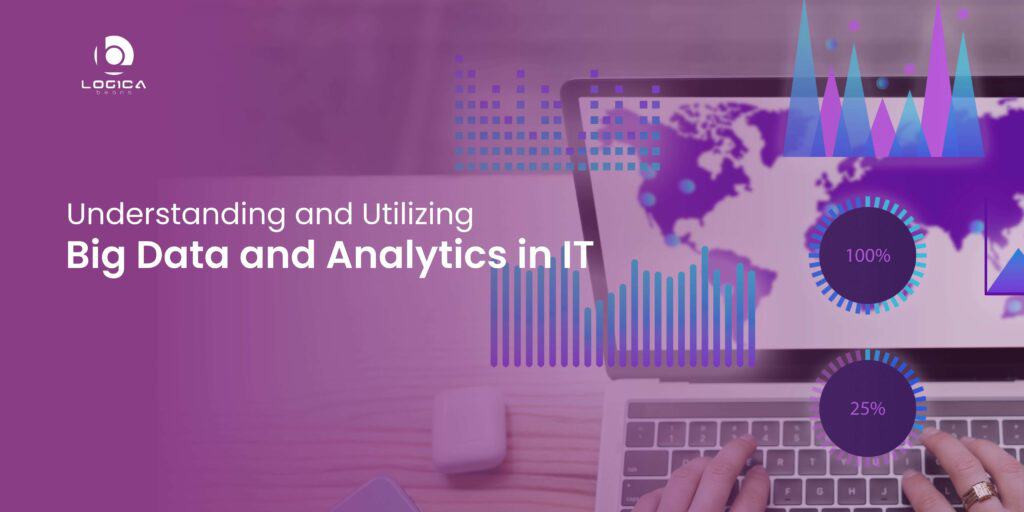Data has become a vital resource for enterprises across sectors in this era of technology. Big data and analytics have transformed the way organizations operate, make decisions, and get insights into their operations. No area illustrates this more than information technology (IT), where the sheer amount, pace, and variety of data created poses both a difficulty and an opportunity.
This blog seeks to offer a thorough grasp of big data and analytics in IT. Whether you’re an IT worker aiming to enhance efficiency or a company executive looking to embrace the power of big data, this exploration will provide you with the information you need to navigate this ever-changing landscape.
Understanding big data and analytics in IT
Big data refers to the collection of extraordinary and complicated data that are difficult to manage, handle, or analyze using typical data processing techniques. Big data is distinguished by three V’s: volume, velocity, and variety.
The huge volumes of data created and gathered from numerous sources are referred to as volume. The pace at which data is created and must be processed in real-time or near real time is referred to as velocity. Variety refers to the many data kinds and forms, such as structured, semi-structured, and unstructured data.
In contrast, analytics is the act of studying, interpreting, and generating valuable insights from data. It involves employing a variety of approaches, algorithms, and tools to find patterns, trends, and correlations in data. Analytics enables businesses to extract important information from large amounts of data and make educated decisions based on those insights.
It includes several forms of analytics, such as descriptive analytics (summarizing historical data), predictive analytics (making predictions based on previous data), and prescriptive analytics (offering suggestions for actions based on data analysis).
Big data and analytics in IT have simplified and democratized the area. A vast quantity of data is created in today’s digital age from many sources such as social media, sensors, online transactions, and more. This surge of data has presented IT workers with both obstacles and possibilities. Innovative solutions have arisen to handle the storage and processing demands of big data.
Role of analytics in big data
Analytics play an essential role in the context of big data for extracting important insights and making educated decisions. Big data is distinguished by its volume, velocity, and diversity, which makes it difficult to process and evaluate using standard approaches. Analytics gives the tools and strategies for extracting insights from enormous amounts of complicated data.
The following summarizes the function of analytics in getting insights from huge data:
● Data Exploration
Analytics aids in the exploration and comprehension of the structure and content of large data. To prepare the data for analysis, it requires data profiling, cleaning, and transformation. Analysts can find patterns, anomalies, and possible links in the data that will drive additional study.
● Descriptive analytics
Descriptive analytics is concerned with summarizing and illustrating the qualities and attributes of data. Data aggregation, data visualization, and statistical analysis are used to create a clear and succinct summary of the data. Descriptive analytics aids in comprehending current events and detecting trends and patterns.
● Predictive analytics
Predictive analytics uses past data to produce predictions or projections about future occurrences or outcomes. It entails using statistical models, machine learning algorithms, and data mining approaches to find patterns and correlations in data. Predictive analytics may be used to predict consumer behavior, improve company operations, and reduce risks.
● Prescriptive analytics
Prescriptive analytics extends beyond prediction to make suggestions on possible actions or interventions to improve results. It recommends the optimum course of action based on numerous restrictions and objectives using optimization algorithms and simulation models. Prescriptive analytics aids decision-making and the identification of the most successful options for a specific circumstance.
● Real-time analytics
Real-time analytics is concerned with processing and analyzing data as it is created in real time. It helps enterprises to make quick judgments and take action based on current information. For applications such as fraud detection, network monitoring, and dynamic pricing, real-time analytics is critical.
Organizations may obtain important insights from big data by employing analytics approaches, allowing them to increase operational efficiency, improve customer experiences, optimize processes, and uncover new business prospects. In today’s data-driven environment, it enables data-driven decision-making, resulting in improved results and competitive benefits.
Utilizing big data in IT
The abundance of data in today’s digital world has created new opportunities for enterprises to capitalize on the promise of big data in the field of information technology (IT). Businesses may discover important insights, promote innovation, and enhance performance by successfully utilizing big data in IT operations. This article investigates the different ways in which firms may use big data in the IT sphere to acquire a competitive advantage and prosper in the digital landscape.
The capacity to obtain deep insights into IT operations and infrastructure management is one of the key benefits of utilizing big data in IT. Organizations have the difficulty of successfully maintaining and improving their IT infrastructure as IT systems, networks, and applications become more complex. Big data and analytics in IT, in addition to network and infrastructure management is critical in enhancing cybersecurity defenses and identifying abnormalities in IT systems. With the emergence of complex cyber attacks, firms must implement strong safeguards to protect their IT assets and sensitive data.
Furthermore, by utilizing big data and analytics in IT, firms may detect fraudulent activities such as anomalous financial transactions or questionable user behavior, therefore limiting financial losses and reputational harm.
Applications of big data and analytics in IT
Big Data and analytics have a wide range of uses in information technology (IT).
Here are a few significant domains in IT where big data and analytics are commonly used:
● IT operations and infrastructure management
They rely heavily on big data and analytics to monitor and manage IT operations and infrastructure. Organizations may obtain insights into system performance, detect possible faults or bottlenecks, and improve resource allocation by evaluating vast amounts of operational data. This contributes to the overall efficiency and dependability of IT systems.
● Cybersecurity and Threat Detection
Organizations holds a big importance of cybersecurity. Big data and analytics in IT can help detect and mitigate cybersecurity risks. Organizations can spot trends and abnormalities that suggest prospective attacks or security breaches by studying network traffic, user activity, and security records. This enables proactive threat detection, real-time incident response, and the deployment of strong security measures to safeguard IT assets and sensitive data.
● Customer Analytics
Using big data and analytics, businesses may obtain a better knowledge of their consumers. Organizations may get significant insights into consumer preferences, behavior, and requirements by analyzing customer data from multiple sources such as transaction records, website interactions, and social media. This data aids in the optimization of marketing tactics, the personalization of customer experiences, and the improvement of customer happiness.
● Business Intelligence and Decision Making
Big data and analytics delivers useful insights for strategic IT decision-making. Organizations may acquire a holistic perspective of their company performance, spot patterns, and make data-driven choices by integrating and analyzing data from many sources. This aids in the optimization of IT investments, the improvement of operational efficiency, and the acceleration of corporate growth.
● Data Management and Governance
Big data and analytics aids in the management and governance of massive amounts of IT data. Organizations may use analytics approaches to assure data quality, enforce data governance regulations, and optimize data management operations. This contributes to data integrity, regulatory compliance, and effective data integration and sharing across IT platforms.
These are just a few instances of how big data and analytics are being used in the world of information technology. Big Data’s potential resides in its capacity to give insights, streamline operations, strengthen security, and allow data-driven decision-making, ultimately driving organizational success in the digital age.
Challenges and Considerations in Big Data and Analytics
While big data and analytics offer immense opportunities, there are several challenges and considerations that organizations must address to effectively leverage them.
Here are some key challenges and considerations in the realm of big data and analytics:
● Data Privacy and Security
As the volume and complexity of data grows, companies must handle data privacy and security problems. Large datasets may include sensitive information, such as personally identifiable information (PII) or intellectual property, when analyzed. Throughout the analytics process, organizations must comply to privacy requirements, establish robust security measures, and maintain secure data handling methods.
● Data Quality and Reliability
Ensuring the quality and reliability of data is a key difficulty in big data and analytics in IT. Big Data is frequently derived from a variety of sources, including structured and unstructured data, and may contain mistakes, inconsistencies, or missing information. To achieve accurate and trustworthy insights, organizations must engage in data quality management methods, data cleansing, and validation methodologies.
● Sustainability and Infrastructure
The sheer volume and velocity of big data offer scalability and infrastructure difficulties. To meet the needs of large-scale data processing and analytics, organizations must invest in strong and scalable infrastructure, including storage, computing power, and network bandwidth. Scalability issues may be addressed via cloud computing and distributed computing frameworks.
● Talent and Skills Gap
Big data and analytics in IT need a professional workforce with skills in data science, statistical analysis, machine learning, and programming. However, experts with these particular abilities are in limited supply. To overcome the skills gap and construct a strong analytics team, organizations must engage in talent development, training programs, and relationships with academic institutions.
● Ethical Concerns
The use of big data and analytics creates ethical concerns, particularly in terms of privacy, prejudice, and discrimination. Organizations must guarantee that data is collected and used ethically, that algorithms are transparent, and that decision-making procedures are fair. These concerns may be addressed with responsible data governance structures and ethical principles.
Organizations can negotiate the intricacies of big data and analytics, discover important insights, and drive successful data-driven projects by addressing these issues and concerns. A clear plan, a competent team, a solid infrastructure, and a commitment to ethical and acceptable data practices are all required.
Implementing big data and analytics in IT
To ensure the success of big data and analytics in IT, a well-thought-out plan, strategic considerations, and a methodical approach are required.
This procedure entails numerous critical phases and factors that must be addressed:
● Understanding Business Goals
Before entering into big data and analytics implementation, it’s critical to have a firm grasp on the organization’s overall business objectives and goals. This entails finding particular use cases and areas where big data may add value, such as increasing IT operations efficiency, boosting cybersecurity measures, optimizing resource allocation, or improving customer experiences.
● Assessing Data Sources and Infrastructure
A thorough examination of existing data sources within the IT ecosystem is required. This entails determining the appropriate data that may be collected and evaluated in order to meet the set goals. Furthermore, assessing the present IT infrastructure is critical to determining if it is capable of handling the increasing data quantities and processing needs that come with big data and analytics. Organizations may consider investing in scalable technologies if necessary.
● Creating a Data Governance Framework
Creating a solid data governance framework is crucial for guaranteeing data quality, integrity, privacy, and regulatory compliance. Data ownership, access restrictions, data lifecycle management policies, and data handling procedures are all defined in this framework. It establishes standards for data collection, storage, integration, and utilization, assuring appropriate and ethical data practices throughout the analytics process.
● Putting Together an Analytics Team
Putting together a talented and diversified team is critical for effective big data and analytics adoption. Data scientists, data analysts, IT professionals, and domain specialists should all be on this team. It is critical to provide adequate training and tools to help them improve their abilities in big data technology, analytical approaches, and data management procedures. It is also necessary to create a collaborative atmosphere that stimulates cross-functional cooperation and information exchange.
● Analytics tools and technology selection
Choosing the correct analytics tools and technologies is a key choice. Consider data storage capacities, processing power, visualization capabilities, and integration with current IT systems. Popular big data and analytics technologies like Hadoop, Spark, data lakes, and data visualization tools may be analyzed and deployed based on the needs and use cases.
● Data Integration and Preparation
It is critical to integrate and consolidate data from multiple sources. This includes guaranteeing the quality, consistency, and correctness of data. Data integration strategies merge structured and unstructured data from many sources, whereas data cleansing and preparation procedures eliminate mistakes, duplication, and inconsistencies. To make the data more useful, data transformation and enrichment techniques are used.
● Creating Analytics Models and Algorithms
Analytics models and algorithms are created using data science and statistical approaches to extract important insights from data. Depending on the aims, machine learning algorithms, predictive modeling, or anomaly detection approaches may be used. These models’ efficacy and relevance are ensured through continuous refining and improvement based on feedback and fresh data.
● Insight Visualization and Communication
Data visualization techniques are used to communicate analytical findings in a visually appealing and intelligible manner. Stakeholders may examine information and make educated decisions by using interactive dashboards, reports, and visualizations. Effective communication of results to both technical and non-technical audiences is critical for promoting understanding and acceptance of big data and analytics insights.
● Monitoring, Evaluating, and Refining
It is critical to continuously evaluate the performance and efficacy of big data and analytics solutions that have been installed. Measuring the impact on key performance indicators and determining if the set objectives are met aid in determining the success of the implementation. Incorporating feedback, learnings, and fresh data guarantees that analytics models and processes are constantly refined and improved.
Conclusion
Big data and analytics are crucial in the field of Information Technology (IT) and provide enormous prospects for businesses. Organizations may use big data and analytics to get useful insights, streamline IT operations, increase cybersecurity, improve decision-making, and drive overall company performance. As data volume and complexity continue to expand at an exponential rate, the future of big data and analytics in IT offers even more potential. Machine learning, artificial intelligence, and the Internet of Things (IoT) will further boost big data analytics capabilities, allowing enterprises to extract deeper insights and drive innovation.










